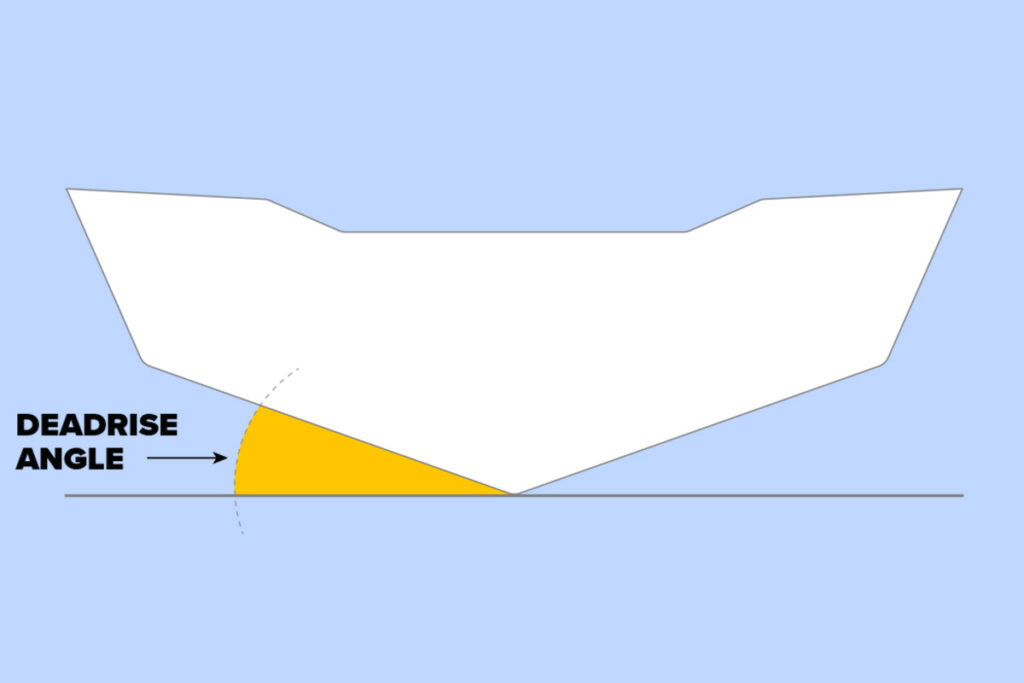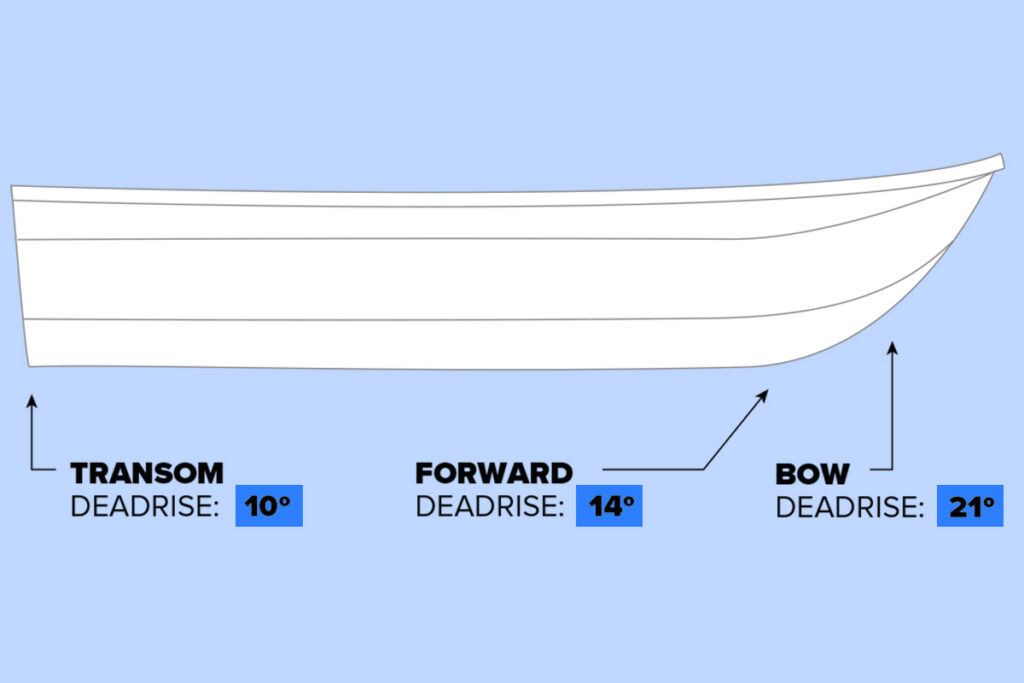If you are a boater or simply interested in boating, you may have heard the term “deadrise” mentioned when referring to the hull design of a boat. Deadrise is an essential element of a boat’s design, affecting its performance and overall efficiency. In this article, we will explore the concept of deadrise and explain its significance in boat design.
What is Boat Deadrise?
Deadrise is a critical concept to understand when it comes to selecting the right boat for your needs. As mentioned earlier, deadrise refers to the angle of a boat’s hull, measured in degrees from a flat horizontal plane. A boat with a steeper deadrise angle will have a more V-shaped hull, while a shallower angle will have a flatter hull.
The deadrise angle impacts the boat’s performance in a number of ways. A steeper deadrise angle is typically associated with better handling in choppy water, as it allows the boat to slice through waves and reduce the impact of rough seas. However, a steep deadrise angle can also reduce the boat’s stability and make it less suitable for certain types of boating activities, such as cruising or watersports.

Conversely, a shallower deadrise angle can result in better stability and a smoother ride in calmer conditions. This can make a boat with a shallow deadrise angle more suitable for activities like cruising or fishing. However, a shallow deadrise angle can also result in a harsh ride in choppy conditions and may limit the boat’s top speed.
In addition to these general considerations, it’s important to note that deadrise angles can vary widely depending on the type of boat and its intended use. For example, a high-performance offshore racing boat may have a very steep deadrise angle of 25 degrees or more, while a displacement trawler designed for long-range cruising may have a much shallower angle of 10 degrees or less.
Overall, understanding deadrise is an important part of selecting the right boat for your needs. By considering factors like the type of boating you’ll be doing, the conditions you’ll be in, and the performance you desire, you can choose a boat with the appropriate deadrise angle to ensure a safe and enjoyable experience on the water.
Why is Deadrise Important?
Deadrise is an important concept to consider when selecting a boat because it can have a significant impact on the boat’s performance, stability, and suitability for different types of boating activities.
First and foremost, deadrise is important because it affects the way the boat handles in the water. A boat with a steep deadrise angle will typically have better handling in choppy conditions, as the V-shaped hull allows the boat to slice through waves and reduce the impact of rough seas. This can make a boat with a steep deadrise angle more suitable for activities like offshore fishing or racing, where a smooth ride in choppy water is critical.
Conversely, a boat with a shallow deadrise angle will typically have better stability and a smoother ride in calmer conditions. This can make a boat with a shallow deadrise angle more suitable for activities like cruising or watersports, where comfort and stability are more important than speed or handling in rough water.
In addition to handling and stability, deadrise can also impact the boat’s top speed and fuel efficiency. A boat with a steep deadrise angle may have a higher top speed but may not be as fuel-efficient, while a boat with a shallow deadrise angle may have better fuel efficiency but may not be as fast.
Overall, the deadrise angle is an important factor to consider when selecting a boat because it can impact the boat’s performance in a number of ways. By choosing a boat with the appropriate deadrise angle for your needs, you can ensure a safe and enjoyable experience on the water, whether you’re fishing, racing, cruising, or enjoying watersports.
Types of Deadrise
There are generally two types of deadrise: planing and displacement.
Planing Deadrise
Planing deadrise is common in boats that are designed to ride on the water’s surface at high speeds. These boats typically have a deadrise angle of 15 degrees or less, allowing them to plane on the water’s surface. This design reduces drag and increases speed, making it ideal for water sports, fishing, and other recreational activities.
Displacement Deadrise
Displacement deadrise is common in boats designed for cruising and long-distance travel. These boats typically have a deep deadrise angle of 20 degrees or more, which allows them to cut through the water more efficiently. Displacement boats move through the water, pushing aside the water, and the hull creates a wave that travels along the length of the hull, reducing drag and increasing efficiency.

Boat Deadrise Measurements
When discussing deadrise, there are three key measurements to consider: bow deadrise, forward deadrise, and transom deadrise.
Bow deadrise refers to the angle of the boat’s hull at the bow or front of the boat. This angle is typically steeper than the other two measurements, as it is designed to slice through waves and provide a smooth ride in choppy conditions. Boats with a high bow deadrise angle are often used for offshore fishing or racing, as they can handle rough seas and high speeds.
Forward deadrise refers to the angle of the boat’s hull between the bow and the mid-section of the boat. This angle is often less steep than the bow deadrise angle, but still plays an important role in the boat’s performance. A forward deadrise angle that is too shallow can result in a harsh ride in choppy conditions, while a too-steep angle can reduce speed and fuel efficiency.
Transom deadrise refers to the angle of the boat’s hull at the transom or rear of the boat. This angle is important for stability and can impact the boat’s performance in different ways. A boat with a deep transom deadrise angle will typically have a higher top speed but may not be as fuel-efficient, while a shallower angle will have better fuel efficiency but may not be as fast. Additionally, a wider transom can provide better stability and weight distribution for activities like fishing or watersports.
Overall, the combination of these three deadrise measurements plays a critical role in a boat’s performance, stability, and suitability for different types of boating activities. When selecting a boat, it’s important to consider all three measurements in order to choose the right vessel for your needs.
Deadrise and Stability
Deadrise also plays a significant role in a boat’s stability. Boats with a deep deadrise angle tend to be more stable in rough waters, while boats with a shallow deadrise angle may feel unstable or uncomfortable. However, a deep deadrise angle also means that the boat will roll more when turning, making it less stable in sharp turns.
Deadrise and Draft
The deadrise angle also affects a boat’s draft, or how much water the boat displaces when afloat. Boats with a shallow deadrise angle typically have a shallow draft, allowing them to navigate shallow waters. Boats with a deep deadrise angle have a deeper draft, which may limit their access to certain areas with shallow water.
Deadrise and Fuel Efficiency
The deadrise angle also has an impact on a boat’s fuel efficiency. A boat with a shallow deadrise angle typically has a higher top speed but may consume more fuel. A boat with a deep deadrise angle may have a lower top speed but is more efficient at cruising speeds, making it more fuel-efficient in the long run.
Choosing the Right Deadrise
When choosing a boat, it’s essential to consider your intended use and the conditions you’ll be boating in. If you plan to use your boat for water sports or fishing in calm waters, a boat with a shallow deadrise angle may be the best option. If you plan to use your boat for cruising and long-distance travel, a boat with a deep deadrise angle may be the better choice.
Boat Deadrise Examples
Table of 10 popular boats with their deadrise measurements:
| Boat Model | Deadrise (Bow) | Deadrise (Forward) | Deadrise (Transom) |
|---|---|---|---|
| Boston Whaler 230 Vantage | 56 degrees | 23 degrees | 20 degrees |
| Grady-White Freedom 275 | 20 degrees | 24 degrees | 19 degrees |
| Sea Ray Sundancer 320 | 21 degrees | 19 degrees | 21 degrees |
| Robalo R230 | 22 degrees | 18 degrees | 22 degrees |
| Regulator 34SS | 24 degrees | 24 degrees | 24 degrees |
| Pursuit DC 365 | 20 degrees | 24 degrees | 18 degrees |
| Scout 350 LXF | 22 degrees | 23 degrees | 20 degrees |
| Intrepid 375 Walkaround | 23 degrees | 23 degrees | 23 degrees |
| Everglades 355cc | 25 degrees | 25 degrees | 25 degrees |
| Tiara Yachts 38 LS | 24 degrees | 20 degrees | 18 degrees |
Conclusion
Understanding the concept of deadrise can help you choose the right boat for your needs and ensure a safe and enjoyable boating experience. Consider the type of boating you’ll be doing, the conditions you’ll be in, and the performance you desire when selecting a boat with the appropriate deadrise angle.
FAQs
What is the ideal deadrise angle for a boat?
There is no one-size-fits-all answer to this question. The ideal deadrise angle depends on the intended use of the boat and the conditions it will be used in.
Can the deadrise angle be modified on a boat?
The deadrise angle is a fundamental element of a boat’s design and cannot be modified without significant structural changes to the hull.
What is the difference between a planing and displacement deadrise?
A planing deadrise is designed for high-speed performance and has a shallow deadrise angle of 15 degrees or less. A displacement deadrise is designed for cruising and has a deep deadrise angle of 20 degrees or more.
Can a boat with a deep deadrise angle handle shallow water?
Boats with a deep deadrise angle typically have a deeper draft, making them less suitable for shallow water conditions.
What is the impact of deadrise on a boat’s fuel efficiency?
A boat with a deep deadrise angle may be more fuel-efficient at cruising speeds, while a boat with a shallow deadrise angle may consume more fuel but have a higher top speed.
- Sustainable and Luxurious: Discovering Split’s Yachting Paradise – April 26, 2024
- MarineTraffic vs VesselFinder: Which Is Better Vessel Tracking Service? – February 14, 2024
- Port Costs: A Comprehensive Guide to Port Dues and Fees for Cargo Ships – February 12, 2024





Leave a Reply